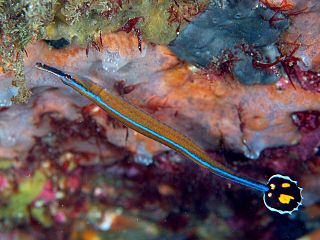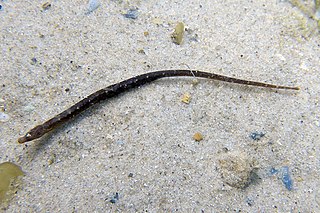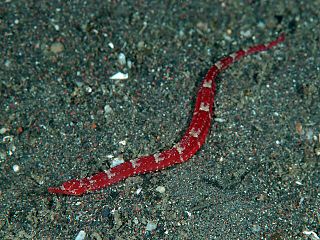
The Syngnathidae is a family of fish which includes seahorses, pipefishes, and seadragons. The name is derived from Greek, σύν (syn), meaning "together", and γνάθος (gnathos), meaning "jaw". This fused jaw trait is something the entire family has in common.

Citharichthys is a genus of flatfish in the large-tooth flounder family, Paralichthyidae. They have both eyes on the left sides of their heads. They are native to the oceans around the Americas, with a single species, C. stampflii off the West African coast. Most are found in relatively shallow depths, but the genus also includes species found in deep water and species that enter fresh water.

Syngnathus is a genus of fish in the family Syngnathidae found in marine, brackish and sometimes fresh waters of the Atlantic, Indian and Pacific Ocean. Fossils of these species are found from the Oligocene to the Pleistocene. They are known from various localities of Greece, Italy, Germany and United States.

Corythoichthys is a genus of pipefishes of the family Syngnathidae. All species in the genus are found in the tropical Indian and Pacific Oceans on reefs or rubble bottoms. Relationships and taxonomy within the genus are still in debate, but there may be at least 23 species.
Dactyloscopus is a genus of sand stargazers native to the coasts of the Americas.

Acanthognathus is a genus of ants that are found in tropical Central and South America. There are 7 living species and 1 extinct species, Acanthognathus poinari, known only from fossil records.

Doryrhamphus is a genus of pipefishes, one of the two genera colloquially known as flagtail pipefishes and are popular in the aquarium trade. The members of this genus are native to the Indian and Pacific Oceans where they inhabit reef environments. The species in this genus have a maximum length of 14 centimetres (5.5 in) or less, with D. janssi being the only species that surpasses 8.5 centimetres (3.3 in). Most species have a horizontal blue line along their body, and all have a whitish-edged tail that is marked contrastingly with black, red or yellow.
Dactylagnus is a genus of sand stargazers, found in the eastern central Pacific and western central Atlantic Ocean.
Gillellus is a genus of sand stargazers, found in the eastern central Pacific Ocean and western central Atlantic Ocean.
Choeroichthys is a genus of pipefishes of the family Syngnathidae native to the Indian and Pacific Oceans.

Bulbonaricus is a genus of pipefishes native to the Indian and Pacific Oceans.

Campichthys is a genus of pipefishes native to the Indian and Pacific Oceans.

Festucalex is a genus of fish in the family Syngnathidae native to the Indian and Pacific Ocean.
Minyichthys is a circumtropical genus of pipefishes consisting of species from the Indo-Pacific and eastern and western Atlantic regions. The genus is characterized as having a maximum standard length of about 60 mm, with two or three anal fin rays. Minyichthys species can be differentiated from members of the closely related genus Micrognathus by their higher frequency of total subdorsal rings.

Epibulus is a genus of wrasses native to the Indian Ocean and the western Pacific Ocean.
Cerdale is a genus of wormfishes native to the western Atlantic Ocean and the eastern Pacific Ocean.

Gunnellichthys is a genus of wormfishes native to the Indian Ocean to the central Pacific Ocean.
Microdesmus is a genus of wormfishes native to the Atlantic Ocean and the eastern Pacific Ocean.
Penetopteryx taeniocephalus, also known as the oceanic pipefish is a species of marine fish belonging to the family Syngnathidae. The species can be found inhabiting coral rubble and gravel in many areas of the Indo-Pacific including Madagascar, Mauritius, the Philippines, Indonesia, and Vanuatu. Its diet likely consists of small crustaceans such as copepods. Reproduction occurs through ovoviviparity in which the males brood eggs before giving live birth.

Urocampus nanus, also known as the barbed pipefish, is a species of marine fish belonging to the family Syngnathidae. The species can be found inhabiting seagrass beds in sheltered shoreline and estuary habitats along the coasts of southern Japan and Korea. Their diet likely consists of small crustaceans. Reproduction occurs through ovoviviparity in which the males brood eggs for 11–16 days before giving live birth. Urocampus nanus is thought to be polyandrous, where multiple females compete over breeding with a single male.











